
Carpal Tunnel
What is carpal tunnel?
Carpal tunnel syndrome (CTS) is a disorder of the hand caused by pressure on the Median nerve as it crosses the wrist through the carpal tunnel. The carpal tunnel is a narrow passageway on the palm side of the wrist, which opens into the hand. It is surrounded by the bones of the wrist (underneath) and the transverse carpal ligament, a tight fibrous band (across the top). There are 9 tendons and a nerve, the Median nerve runs through the carpal tunnel. The Median nerve controls some of the muscles that move the thumb and gives feeling to the thumb, first finger, middle finger and half of the ring finger.
What are the symptoms?
Prolonged pressure on the nerve in the carpal tunnel will damage the nerve and can cause a number of symptoms:
- Numbness and tingling - this can occur in the thumb. First, middle and half of the ring finger and may be painful or not. In mild cases it comes on when the wrist is held bent in one direction for a long period of time or at night time. Patients may wake up with a tingling, dead hand. In severe cases the fingers and thumb can be permanently numb.
- Aching and pain – this is often in the hand and comes on with tingling. It may also start at the wrist and cause pain up the arm.
- Clumsiness and weakness – patients often drop things due to the reduced feeling or weakened grip in more severe cases.
What are the causes of this condition?
Most often there is no cause for CTS although risk factors include:
- Diabetes
- Repetitive manual work
- Hypothyroidism
- Previous trauma
- Rehumatoid arthritis
- Obesity
- Kidney failure
- Pregnancy
- Neck arthritis
- Menopause
- In some cases, there may be a genetic link.
Your GP or surgeon may arrange a test called a Nerve conduction study to confirm the diagnosis. This test is not always sensitive at picking up this problem. Even if the test is negative, you may still be having CTS. The test however can give an indication about the severity of the condition and also diagnose other conditions which may be confused with this.
What treatments are available for this condition?
Surgery
The operation is meant to relieve the pressure of the nerve and by doing so, you should get improvement in the pins and needles in the fingers. You may also get improvement in the strength in the muscles of the hand. This improvement may be instant or gradual over 12-18 months. In cases of advanced compression, the nerve may not recover fully even after release and in those cases, surgery prevents further damage.
Treatment for Carpal tunnel syndrome is a worthwhile operation which usually relieves your symptoms if they are intermittent and improve them to some extent in more severe cases. Treatment can improve your hand's function and reduce the stress and sleep interference of symptoms. Treatment is usually safe, but complications can happen
Painkillers
In mild cases of CTS, Ibuprofen or similar drugs can provide some short-term relief from symptoms. Nerve symptoms may be relieved by specific nerve painkillers from your GP however some patients find the side-effects of these problematic.
Postural adaptations
Avoiding prolonged periods with the wrist bent may help to relieve the symptoms. Splinting the wrist at night helps many patients, if this is effective no further treatment may be necessary. Some patients may choose to live with the pins and needles and decide not to have an operation.
Injection
Injection of steroid into the carpal tunnel can provide a good relief of symptoms for up to 1 year. Steroid injections can be used as a nonoperative treatment method, but also as a diagnostic tool when there is any doubt as to where the patient’s symptoms originate from. In patients who have diabetes, steroid injections can cause elevation of blood glucose for one to two days that doesn’t require further intervention.
Steroid injections are not routinely repeated when the patient’s symptoms recur.
What happens on the day of surgery?
Admission
On the day of surgery, you will be admitted by a nurse who will check your details, medications and past medical conditions and put a wrist band with your details on the arm we are not operating on (if we are operating on both hands this band is put on your ankle).
Remove any rings before you come to hospital and if you are unwell or have any cuts on your hand or arm then please inform us before the day as this may require your operation to be delayed.
Anaesthetic
A local anaesthetic will be used where you will be awake for the operation, but the area will be numb. In some cases, a general anaesthetic may be required, you may also be given a sedation during the local anaesthetic or an axillary block where you will be awake but the whole of your arm will be numb for 12 hours.
If staying awake for your surgery, there is the option to listen to music or watch a video on the tablet screens and headphones we have in theatre. Alternatively, you can bring your own device to listen to music on, but you must have headphones.
Depending on what anaesthetic you have, you may have to starve for your surgery. You will be advised before your admission whether you will have to starve or not.
Surgery
Surgery time varies from 10-30 mins depending on the complexity of the surgery and your surgeon will be able to tell you about the rough operative time on the day of surgery.
Once numb the surgeon will release the tight ligament via a cut in the midline of your palm just past where the wrist creases. This will be stitched and dressed with a bulky bandage or occasionally a plaster cast.
After surgery
Almost all patients will go home on the day of surgery. Very occasional, social or medical conditions require an overnight stay.
What are the possible complications from this operation?
Whilst the surgical team makes sure that the operation is carried out with utmost safety, complications may still happen. Your surgeon should have discussed these with you. The percentage of values given cover a range from simple to complex cases. There are risks with the anaesthesia and your anaesthetist will discuss them with you.
- Bleeding – often this operation is carried out under a tourniquet, bleeding may happen after the operation is finished causing marked bruising and wound oozing (2-5%). Very rarely if a blood clot collects under the skin you may need an operation to remove it and stop the bleeding.
- Infection – this is rare (1-5%) following this operation but if it happens, you may need to have antibiotics. In very rare cases another operation.
- Scar - the scar will normally be tender for 6 weeks however in up to 19% of cases this may last longer and could be 3-6 months.
- Pain – persisting nerve pain can occur in 2-5%. Pillar pain which is pain either side of the scar and deep in the wrist is very common for 4-6 week. In some cases (1-18%) it can persist for many months.
- Nerve injury - the risk of injury to the main nerve, a small skin nerve which supplies part of the palm or a branch which supplied the muscles of the thumb is rare (less than 1%). If this happens you may have permanent numbness to your fingers and weakness to your hand.
- Continued symptoms - your symptoms usually improve within a few weeks after the operation but in some cases, often those with more severe nerve damage, it may not improve. There is a small risk that the symptoms may be worse due to dissection around the nerve. Occasional further surgery may be required if symptoms persist (2-18%).
- Weak grip – in less than 1% of patients the operation can make the grip strength worse once recovered.
- Complex regional pain syndrome - Very rarely you can develop a condition called complex regional pain syndrome (CRPS) (less than 1%) which can make your hand red, swollen and painful. This is a difficult condition to treat and may last for several years. Treatment consists of pain killers and hand therapy.
- New problems - occasionally surgery on the hand, if extensive, can cause other problems such as trigger finger (5-32%).
What should I do about my medication?
Let us know about your medication in the clinic. For all procedures other than local anaesthetic procedures you will be seen in the preassessment clinic before surgery who will advise exactly what to do regarding any medications which you will need to reduce or stop.
What can I do to make the operation a success?
- If you smoke it is best to stop or reduce as much as you can. If you are diabetic, you will reduce your risk of infection and poor wound healing by keeping your blood sugars stable. Please attend all dressing, doctor and hand therapy appointments after surgery. You must follow the hand exercises that you have been given to get the best function and recovery following surgery.
What happens after my surgery?
Once you are home you need to rest and elevate your hand in the sling for 24-48 hours. You may be able to use your hand for light activities (dressing etc.) after that. The bulky bandage will make it difficult to wear normal clothes and you may need to wear a loose short sleeved top or t-shirt. If you are having a shower you will have to put a waterproof plastic bag to cover the bandage.
The dressings will be changed between five and seven days in the clinic. You may be able to do more things using your hand at this stage and if the stitches are dissolvable ones, you can even get it wet.
If dissolvable, stiches will start to fall out when washing your hand between 2-3 weeks. If the stitches are not dissolvable we will arrange to remove them either in the clinic or at your GP.
The appointments after this will depend on your recovery at the initial review. Once fully recovered you will be discharged.
How long will it take to recover?
In mild cases where the symptoms were intermittent through the night, the numbness will subside within a few days after surgery. If there is weakness or constant numbness before the operation, this can take longer to subside and the hand might not fully recover.
Improvements can continue up to 1 year. If your symptoms fail to improve your surgeon will assess you during the next appointment and advise you.
You can drive when your wounds are healed and you feel you can safely grip the steering wheel in both hands to control the car. This usually takes 3-6 weeks. Any heavy physical work may be possible only after six weeks.
You can shower or bath as normal once the wounds are healed, but prior to that you need to keep the hand dry. If you have any issues such as scar pain we will arrange for you to see the Hand Therapist who will help.
After surgery information
- Elevate your hand in a sling whilst mobilising and on a pillow when sitting or in bed.
- Do not allow your hand to hang down by your side.
- Keep the dressing dry, try not to disturb the dressing until you have been advised to.
- Do not partake in heavy manual work until you have been seen at your next appointment and have been advised it is safe to do so.
- Take painkillers as prescribed.
- If you are instructed to wear a sling, please ensure you remove your arm from the sling every 1 to 2 hours and exercise the shoulder and elbow to prevent them from getting stiff. Remember to also wriggle your fingers.
If you experience pain, numbness, tingling, excessive swelling, discharge through your dressing or discoloration of the fingers, in the first instance please contact the Outpatients Department (Mon - Fri, 8:30am - 4:30pm).
Outside of these hours, please contact the main hospital number and ask for the Clinical Site Co-ordinator on call via 0121 685 4000.
If you are unable to make your Outpatient appointment, please contact the Appointments department on 0121 812 3200.
Post-operative exercises
Finger Exercises
Starting from a straight position, do 10 repetitions of each type of fist shown
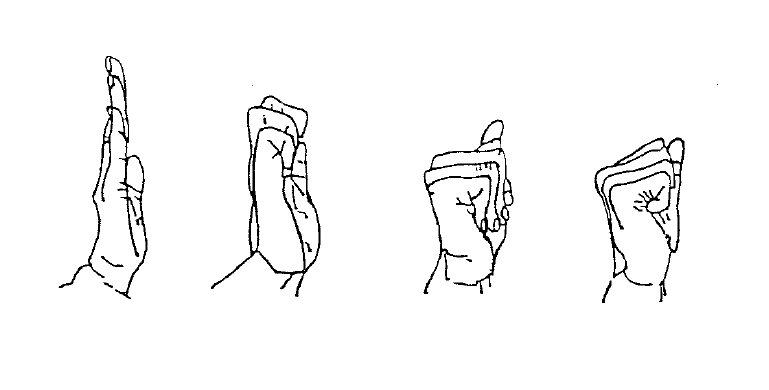
Wrist Exercises
The following exercises will help to improve the movement in your wrists. Carry out 10 times each, 3 times per day.
Put the palms of your hands together, with your fingers pointing upwards. Keeping your fingers together gently lift your elbows out to the side until you feel the stretch over the front of your wrists.
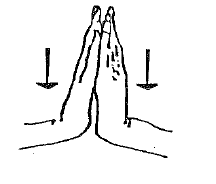
Place your elbow on the table and twist your hand and forearm clockwise and anti-clockwise.
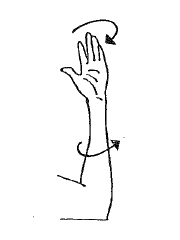
Resting your forearm on a table, with your wrists free over the edge, bend and straighten your wrists as far as you can 10 times, then bend your wrists from side to side, then rotate your wrists in circles. Keep your forearms in contact with the table.
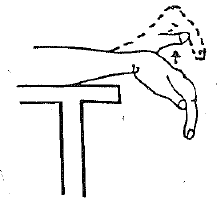
Therapy information
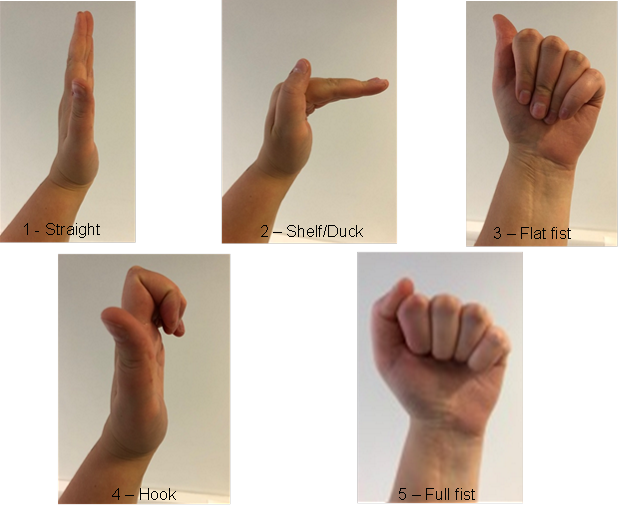
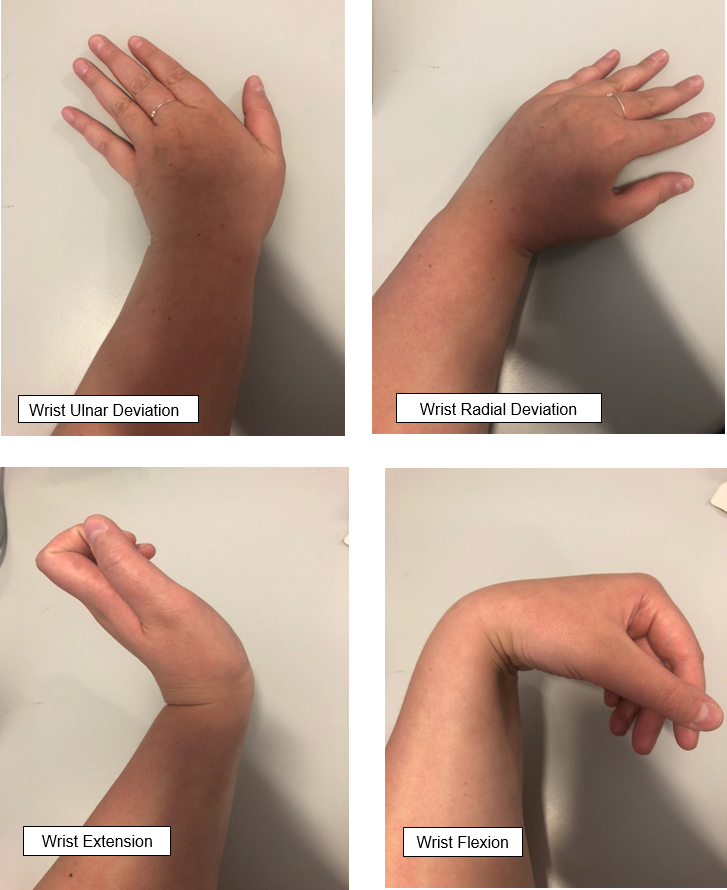
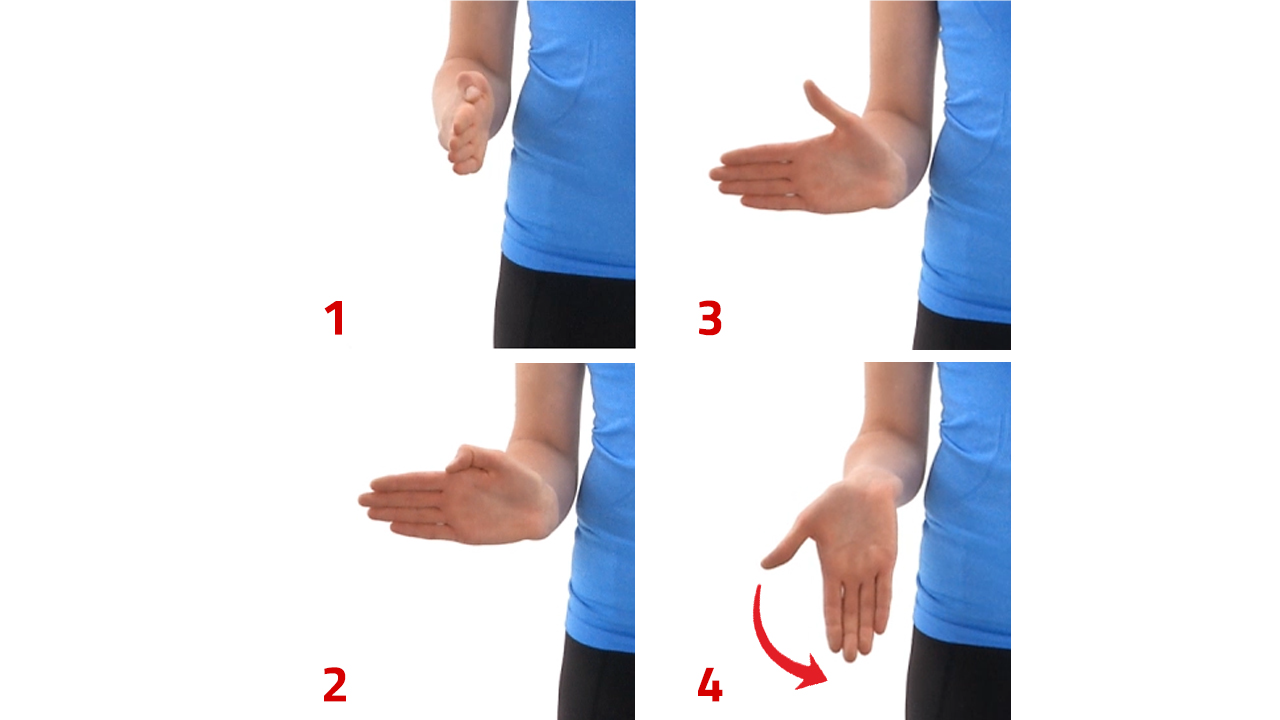
- Begin with your elbow on your side, your hand in a soft fist, and your forearm neutral—so your thumb is up. Stop at any point that you feel a tingle or stretch.
- Open your fingers straight.
- Extend your wrist back.
- Spread and straighten your thumb.
- Keep your wrist and hand in this position and rotate your palm.
- Then use your other hand to gently stretch your thumb back straight. Hold a few seconds then release and relax.
- Repeat.